Main Appositive Takeaways:
- Appositives are nouns, pronouns, or noun phrases that help add more information about other nouns. They sit next to the noun that they identify or describe.
- Appositives can be a single word or a phrase.
- The two types of appositives are restrictive and nonrestrictive.
- Restrictive (essential) appositives are essential to the meaning of the sentence. You don’t need a comma or parenthesis to offset these kinds of appositives.
- Nonrestrictive (nonessential) appositives are not essential to the meaning of the sentence. You need a comma to offset these kinds of appositives.
The word appositive sounds like a happy term, and for a good reason. When you want to spice up your writing or add extra information, appositives do the trick. But are you using them correctly? Should they have commas or not? This easy article will cover everything you need to know about apposition with simple examples and clear explanations.
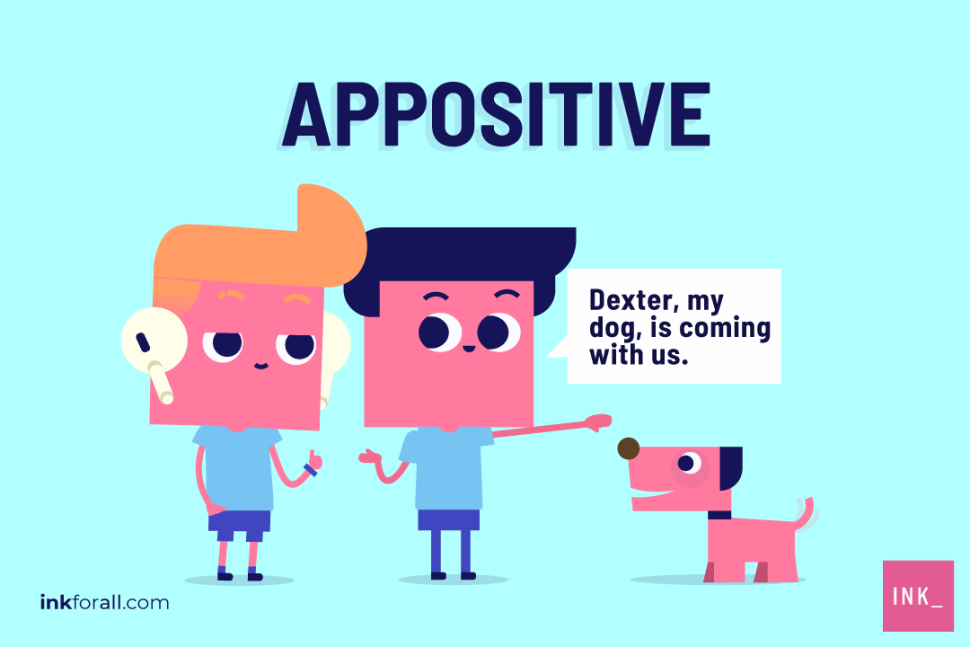

What Is an Appositive?
In English, an appositive can be a noun, noun phrase, or pronoun next to the main noun or pronoun that helps identify or explain the main noun. Appositives in English often appear with modifiers. They may be a single word or several words, but the intent is the same. In other words, an appositive is a way to add supplementary detail about the main noun in a sentence. In fact, the word appositivecomes from the Latin word appositivus, which means subsidiary or supplementary.
What Is Apposition In English Grammar?
Apposition is the process in which two coordinate elements — mostly noun phrases — are placed side-by-side in a sentence. We call these elements appositives. These two elements denote the same subject and have the same relationship with the other sentence elements. However, the second appositive often describes the first.
The purpose of apposition is to identify, explain, or add more details about the main noun or pronoun in a sentence. In this way, apposition makes writing richer by adding more information.
Types Of Apposition In English
Apposition is classified into two types: restrictive apposition and non-restrictive apposition. In restrictive apposition, the second appositive is considered a part of the first appositive. Meanwhile, in a non-restrictive apposition, the second appositive is not a part of the first appositive. Here are some examples to illustrate these two types of apposition:
Restrictive Apposition
Non-Restrictive Apposition
In a non-restrictive apposition, the second appositive is preceded by and set off with a comma. Its purpose is to provide additional information about the first appositive.
What Is an Appositive And Appositive Phrase?
An appositive defines or identifies the main noun or pronoun that it sits beside. An appositive phrase is made up of an appositive and its modifiers. There are two types of appositives. First, nonrestrictive or nonessential appositives provide nonessential information about the main noun or pronoun. This type is nonessential because if you remove it from the sentence, the sentence still makes sense. Second, restrictive or essential appositives provide essential information about the main noun. If you remove it, the sentence no longer makes sense.
Remember, appositives can be either a single word or a multi-word phrase. For instance, you could describe your boss by her name, Jenny, or describe her as an award-winning journalist. The first is a single-word appositive, while the second would be considered an appositive phrase.
Why Are Appositives Important?
Appositives are an important writing tool because they help add color and detail to writing. For example, appositives add variation and improve rhythm by offering an alternative to lots of short, consecutive sentences. Furthermore, appositives can help make your writing more concise and interesting. They do this by helping combine multiple simple sentences into one complex sentence with a more captivating flow.
[Example]Carleen is a Canadian national. Carleen is an accomplished writter.[/example]
What Is an Example Of Appositives?
Appositives are noun or noun phrases that sit beside the main noun. It describes, helps identify, explains, or gives more information about that main noun. For example: My cat, Bengal, is bigger than you might expect. In the example, “my cat” is in apposition to “Bengal.” This is because “my cat” is describing or defining what “Bengal” is.
Here are more examples of appositives and apposition in action:
In each of these cases, the appositives offer additional information about the noun or pronoun that they describe. For instance, without appositives, we wouldn’t know that Professor Robinson is the only teacher with tenure.
How Do You Write an Appositive?
Appositives can come at the beginning, middle, or end of a sentence, but they must contain a noun. What’s more, the appositive should come directly after the noun or pronoun that it describes. That said, here’s how to correctly write an appositive: First, find a main noun in a sentence. Then, directly next to the main noun, insert a noun, pronoun, or noun phrase that further identifies or explains that main noun. If the appositive is essential or restrictive, you don’t need to offset it with commas or parenthesis. However, if it is essential, you do.
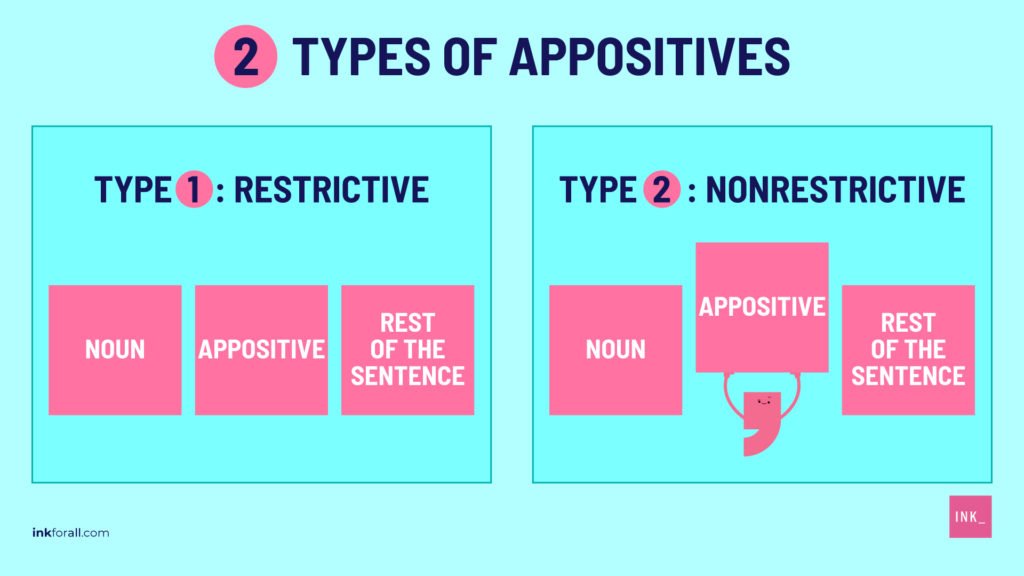

What Are the Two Types Of Appositives?
The two types of appositives are essential and nonessential. Each type is punctuated differently, so it’s important to know the difference. For example, essential (restrictive) appositives are not offset with commas or parenthesis. They contain information that is essential to the sentence, and the sentence would be unclear with out it. Conversely, nonessential (nonrestrictive) appositives are offset by commas or parenthesis. They contain information that interesting but not essential to the sentence. If you remove it, the author’s original meaning will still be clear.
The fact that Gordon Ramsay is known for turning around failing restaurants is true, whether or not we also know he’s a Michelin-star chef. Therefore, the Michelin-star clause is a bonus rather than being essential. The correct structure here is to offset the appositive (a Michelin-star chef) with commas.
Nonrestrictive appositives can also come at the end of a sentence. In that case, you would use a single comma just before the appositives or appositivephrases, and a period in the end.
In some cases, an appositive is necessary to the sentence. So, it becomes restrictive. Because it can’t be removed without changing the meaning of the sentence, the appositive is not offset by commas.
“Lebron James” is restrictive, because without it, we wouldn’t know which basketball player is making that special appearance.
1. What Is an Essential Appositive?
Some appositives are essential (also called restrictive). They are called this because the information they contain is essential to the sentence. For instance, if you remove the appositive, the meaning of the sentence changes. As such, we’re restricted from removing it. Essential appositives aren’t offset but commas, dashes, or parentheses.
2. What Is a Nonrestrictive Appositive?
When you remove a nonrestrictive or nonessential appositive from the sentence, the subject of the sentence is still clear. Therefore, a nonrestrictive appositive contains additional information about the subject that is nice to have and helps add detail to the sentence, but is not essential to the meaning of the sentence. As a result, you are not restricted from removing it from the sentence. Always use commas or parentheses to offset nonrestrictiveappositives.
Without the appositivephrase“Ms. Lu” in the sentence, you would have no idea which teacher wants to see you after class. Since the phrase is essential, or restrictive, no commas are necessary.
It’s a nice little tidbit to learn that Rachel is an employee of Bloomingdale’s. But that doesn’t change who she’s in love with. It’s fun information, but not essential. That makes it a nonrestrictive phrase. For this reason, we know to offset it with commas.
You can also offset nonrestrictiveappositives in other ways if the alternatives suit your style and purpose.
Can You Have Two Appositives In a Sentence?
If you are careful not to overwhelm the reader with too much information, multiple appositives can be an effective writing tool. On one hand, double or triple appositives can help add detail and additional information to your sentence. Additionally, they can also help create a distinct style and flow. On the other hand, you may run the risk of sounding repetitive or burying your reader in too much detail or information at one time. All in all, don’t overuse apposition in your work.
Appositives are a simple way to infuse your writing with color and interest. However, that’s the case if you handle them properly. Pay attention to sentence structure, double-check your punctuation, and ensure your meaning stays intact no matter what.
What Is an Emphatic Appositive?
Emphatic appositives are appositives that appear at the end of a sentence. A colon or an em dash often precedes them. Most writers use emphatic appositives to highlight or call attention to important ideas. If you encounter these appositives, it’s like the writer is waving at you while pointing to the end of the sentence. Here are some examples of emphatic appositives:
Before you start using emphatic appositives in your content, make sure that you know what punctuation to use. A colon functions like a period. Meaning, you need to make sure that you’re going to use it after a complete thought. It lets your readers know that what’s next is essential.
A colon generally precedes longer appositives. Meanwhile, an em dash is more appropriate for one-word or shorter appositives.
How Well do you Know Appositives? Take This Quick Quiz
Appositive Question #1
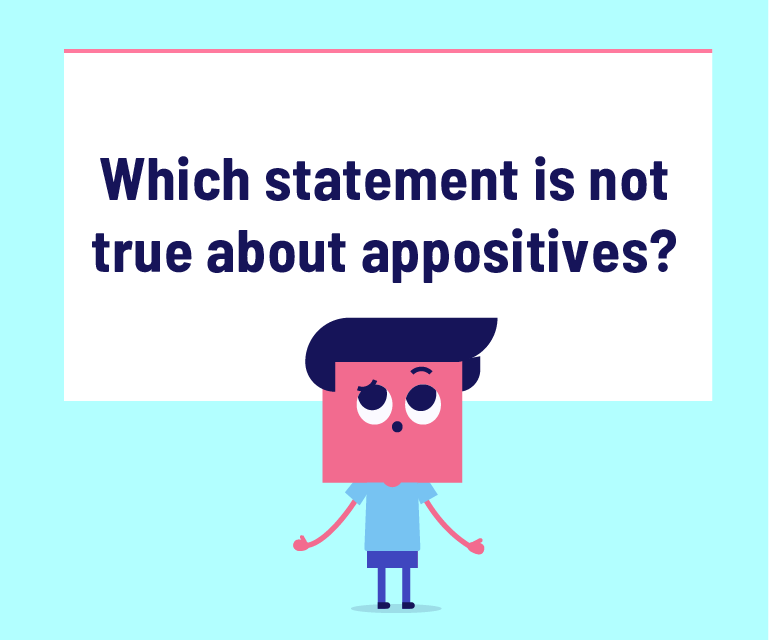

The answer is B. Appositives are usually nouns or noun phrases.
Appositive Question #2


The answer is B. "My sister" is defining or describing who Nina is.
Appositive Question #3
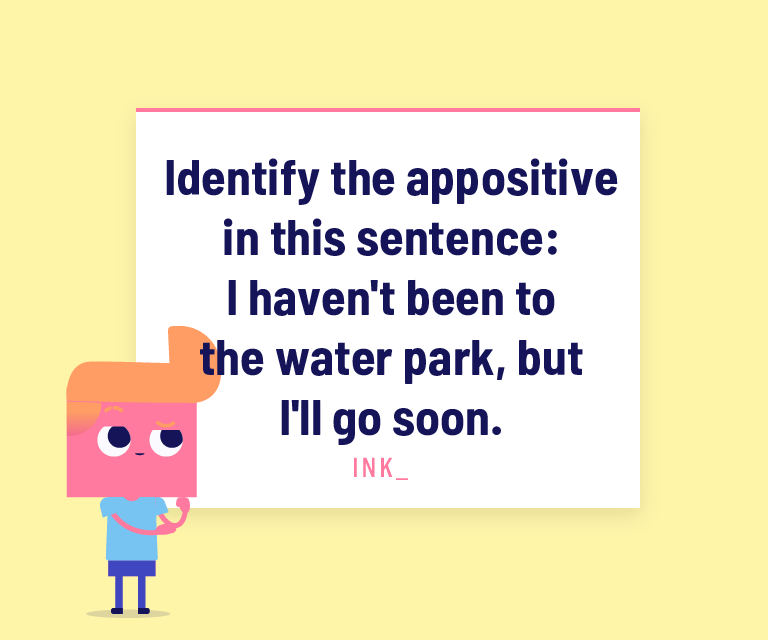

The answer is D. This sentence does not have an appositive phrase.
Appositive Question #4
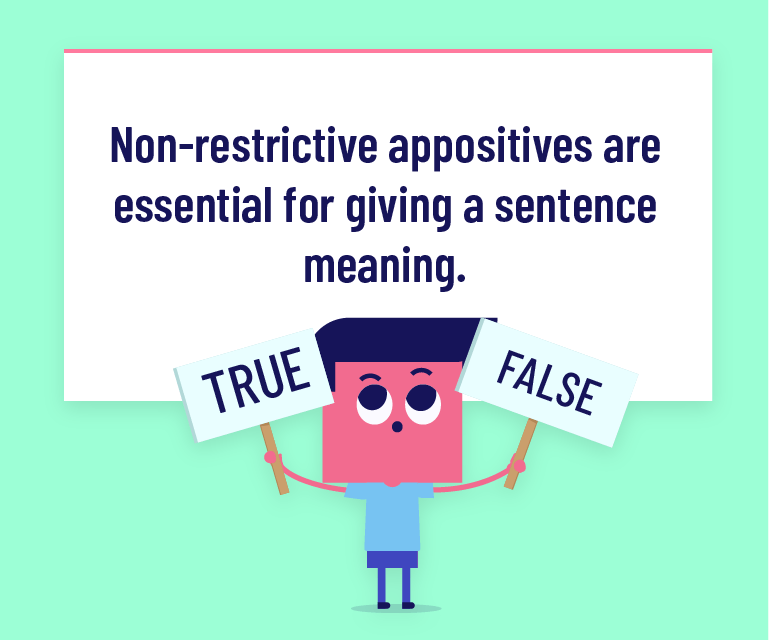

The answer is FALSE. Non-restrictive appositives don't contribute to the sentence's meaning.
Appositive Question #4


The answer is B. The additional information, "a sports car," is not essential.
Appositive Question #6
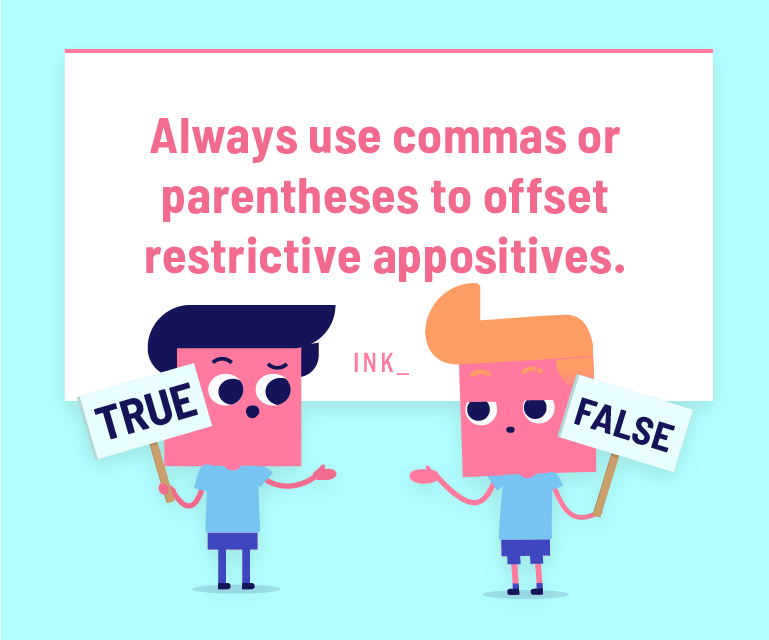

The answer is FALSE. Only use commas or parentheses with non-restrictive appositives.

Hi Krista. You make some remarkably interesting points. How would you respond to the position that one should avoid appositives because they are mostly redundant, also known as superfluous. ; )
In my opinion, appositives chop up writing and make it flutter like a bird with a broken wing. Most of the information in appositives can be smoothly integrated into the broader text without the interruptions. Here is an example of the use of an appositive in Rock (2007) from the Journal of Pragmatics: “Zenia herself was present only in spirit, said the lawyer, and also in the form of her ashes, which they would now proceed to the Mount Pleasant Cemetery to inter.” Here is a smoother version of the same sentence: “The lawyer said that Zenia was present in the form of her spirit and ashes before they proceeded to the Mount Pleasant Community for internment.” The second is better. By organization and definition, the appositive subjugates the information contained within it into a non-essential form making writing appear cluttered with seemingly irrelevant information that is actually essential.
Hi, Jessie! Thank you for such a thoughtful comment. For me, the question is not whether to use appositives, but rather when. I find that language (and life) rarely work in absolutes, so I hesitate to say there is a hard and fast rule here. Instead, I would respond that, like most things in life, there is a time and place for everything, including the use of appositives. Whether or not an appositive hinders a sentence or makes it soar depends on the context. For instance, like technology or a hammer, literary devices are a tool. How effective those tools are depends on how and when we use them. For example, conciseness and a linear structure are key for technical, academic, or SEO writing. For this reason, I would agree that appositives can make a sentence less direct or active, but not necessarily. On the other hand, creative writing allows us to use these tools with a greater degree of elasticity. For this reason, other types of writing with more passive constructions and longer, less linear sentences might be a more appropriate context for appositives. In this way, I agree that your example from Rock is problematic, but for a slightly different reason: active vs. passive voice. The edit you included is more active and concise. Although “better” may be subjective, the edit is absolutely clearer and more readable (and understandably better in these senses!). A winding appositive phrase in a passive construction becomes a neat, one-word adjective in an active construction. Again, this is a question of context and style, and choosing to use the construction and literary devices that help you best express yourself. Therefore, my response is very Machiavellian: it depends on the context and your audience. I am never for absolute answers or excluding any sort of tools or data. I think our job is to use our creative ingenuity to understand and use that understanding to improve. Thus, everything is useful, we just need to figure out how and when.
Thank you again for your kind and thought-provoking comment. Have a happy and safe New Year!
Thanks Krista for a wonderfully cogent response. I agree with you. Writing is art and even a mistake is sometimes beautiful.